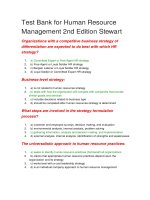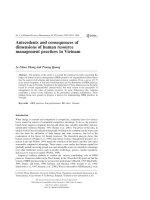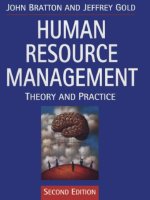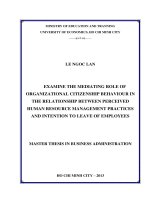Human resource management theory and practice 2nd bratton and gold
Bạn đang xem bản rút gọn của tài liệu. Xem và tải ngay bản đầy đủ của tài liệu tại đây (5.83 MB, 654 trang )
Page i
Human Resource Management
Theory and practice
Page ii
This page intentionally left blank.
Page iii
Human Resource Management
Theory and practice
second edition
John Bratton and Jeffrey Gold
Page iv
First published 1999 by
MACMILLAN PRESS LTD
Houndmills, Basingstoke, Hampshire, RG21 6XS
and London
First published in North America 2000 by
Lawrence Erlbaum Associates, Inc.
10 Industrial Avenue
Mahwah, New Jersey 07430
Copyright © 1999 by John Bratton and Jeffrey Gold
All rights reserved. No part of this book may be reproduced in any form, by photostat,
microform, retrieval system, or any other means, without the prior written permission of the
publisher.
Lawrence Erlbaum Associates, Inc., Publishers
10 Industrial Avenue
Mahwah, New Jersey 07430
Library of Congress Cataloging-in-Publication Data
Bratton, John
Human resource management : theory and practice / John Bratton and Jeffrey Gold –
2nd ed.
p. cm.
Includes bibliographical references and index.
ISBN 0–8058–3862–7 (pbk.: alk. paper)
1. Personnel management. I. Gold, Jeffrey. II. Title.
HF 5549 .B789 2000
658.3--dc21
00-033167
Books published by Lawrence Erlbaum Associates are printed on acid-free paper, and their
bindings are chosen for strength and durability.
Printed in Great Britain
10 9 8 7 6 5 4 3 2 1
Page v
To our families
Amy, Andrew and Jennie Bratton
Susan and Alma Gold
And to the memory of our parents:
Arthur and Florence Bratton
and Harry Gold
Page vi
After a few years away from their MBA programs,
most managers report that they wish they had focused more
on people management skills while in school.
Margaret Wheatley,
Leadership and the New Science, 1994, p. 144
Page x
Manpower planning
Human resource planning
Reconciling the soft–hard dilemma
External and internal labour
Career management
HRM in practice 6.1: Nationwide moves over to telework
HRM in practice 6.2: Staff value a career path above salary
Summary
Chapter case study: Career Management at JJJ Bank plc
7 Recruitment and selection
Jeffrey Gold
Chapter outline
Introduction
Recruitment, selecton and HRM
HRM in practice 7.1: Ethnic minorities aim for high-flying squad
Strategic intervention
Commitment
Flexibility
Quality
Attraction
HRM in practice 7.2: Car traders rally to find graduates
Selection
Summary
Chapter case study: Meister Software UK
part four
Rewards and Development
8 Performance appraisal
Jeffrey Gold
Chapter outline
Introduction
Performance appraisal and the HRM cycle
Assessment, appraisal and control
From control to development
167
173
174
176
179
180
183
185
187
189
189
190
191
192
194
194
195
195
196
198
201
207
208
211
213
213
214
214
214
219
Appraisal and performance management
HRM in practice: Judgement day looms for church ministers
HRM in practice: Performance management in Barclays Mortgages
Inputs
Results and outcomes
Behaviour in performance
Summary
Chapter case study: Hamilton Foods Ltd
9 Reward management
223
226
229
231
231
232
233
234
237
John Bratton
Chapter outline
Introduction
Reward in organizations
Types of reward
Developments in reward management
Rewards and the HRM cycle
237
238
238
240
242
245
Page xii
The nature of employee involvement
HRM in practice 11.1: Report finds partnership equals profit
A general theory of employee involvement
Organizational communication
Approaches to organizational communications
Interpretivist approach
Critical approach
Developing a communication system
HRM in practice 11.2: Broadmoor primed for it's 'domestic works
council'
Two-way communication
Briefing groups
Monitoring the communication system
Information disclosed by management
The extent of organizational communication
Joint consultation
Models of communication
The structure and operation of joint consultative committees
The effects of employee involvement on performance
Obstacles to employee involvement
Trade union attitudes
HRM in practice 11.3: The key to staff commitment
Management attitudes
Summary
Chapter case study: Communications at Forrest Computer
Services
12 Human resource management and industrial relations
John Bratton
Chapter outline
Introduction
Industrial relations
Industrial relations and the HRM cycle
Management practices
Constraints and choices
301
304
305
307
308
309
309
310
311
312
315
315
316
316
318
318
321
324
324
324
325
327
328
329
333
333
334
336
336
336
337
Management strategies
HRM in practice 12.1: Vauxhall deal on pay and flexibility gets
green light
Managerial styles
HRM in practice 12.2: Brewer and union agree national deal
Trade unions
Trade union membership
Interpreting trade union decline
Trade union structure
Union bargaining power
HRM in practice 12.3: NHS trust gets close to 'no strike' deal
Collective bargaining
Collective bargaining structure
Collective agreement
Strategic choice and collective bargaining
Trade unions and HRM
Worker commitment
Trade union's strategic responses
Summary
Chapter case study: East City Council
337
339
341
343
345
345
348
350
352
353
354
354
356
356
357
357
359
364
365
Page xiv
List of tables
page
15
1.1 Ranking of HRM activities of general managers and HRM
specialists, 1990
3.1 The economic context of trading organizations, 1984 and 1990 80
3.2 Summary of gross domestic product, 1990–2005
82
3.3 Non-regular forms of employment, selected countries, 1973– 83
93
3.4 Technical change, 1984 and 1990
87
3.5 Changes in labour force and participation rates, 1960–93
92
5.1 Arrangements for dealing with health and safety, 1984 and
155
1990
7.1 Summary of research on selection interviews
204
8.1 Performance appraisals – findings from the General Electric
216
Company study
8.2 Self–other rating agreement and HRM
225
8.3 The inputs of a development centre held for managers at
228
Yorkshire Water plc
11.1 Some methods used by managers to communicate with their 314
employees, 1984–90
11.2 Information given to employees or their representatives, by 317
ownership in the private sector, 1990
11.3 Extent of JCCs by sector, 1984–90
320
11.4 Extent of JCCs by workplace and organization size, 1998
321
12.1 Trade union membership in the UK, 1971–96
346
12.2 Indicators of union presence by workplace size and
347
management attitudes, 1998
12.3 Trade union membership by country as a percentage of all 347
employees, 1970–95
12.4 Change in membership of the 10 largest TUC affiliated
351
unions, 1979–98
12.5 Strikes and working days lost due to stoppages, 1990–96
352
12.6 Basis for most recent pay increase in private manufacturing, 355
1984–90
12.7 The proportion of the workforce covered by collective
355
bargaining and statutory sectoral wage arrangements by country,
1980–94
Page xix
Preface.
The field of human resource management is one of the most dynamic and challenging
areas for European managers. The turbulent business climate, caused by increased global
price competitiveness, changing technologies, changing employment legislation, and
changing workforce composition is challenging managers to utilize their employees more
effectively to gain competitive advantage. In recent years there have been significant
practical developments with increasing numbers of private and public sector organizations
adopting HRM initiatives alongside downsizing and 're-engineering' the organization. The
change towards more knowledge-based work and the growing acknowledgement that
workers are the key to sustainable competitive advantage have strengthened the case for
'new' human resource management initiatives.
In academia, new human resource management books (Townley, 1994; Storey, 1995;
Legge, 1995) have been published since we produced the first edition of Human Resource
Management: Theory and Practice. Increasingly, HRM scholars have emphasized strategic
aspects of HRM, adopted new perspectives and critically examined the new theoretical
frameworks or HRM models. An important theoretical development which supports the
central tenets of HRM is the integration of strategic management, organizational
development, and adult learning to create a resource-based theory of competitive
advantage. In addition, empirical-based data has been gathered, analysed and published on
the extensiveness of HRM practices in North American and European organizations.
This second edition builds on the success of the first edition by incorporating these latest
ideas, theories and research findings in HRM, to provide a comprehensive overview of HRM
theory and a close examination of developing HRM practices. Like the first edition, it
includes mini-cases and examples that describe HRM practices in Europe and elsewhere. All
the material retained from the first edition has been edited for improvements in style and
references have been updated. New in this edition is a chapter which focuses on strategic
HRM and examines new evidence on the HRM–organizational performance link. New also is
a discussion on workplace learning in Chapter 10 and issues in international HRM are
considered in the final chapter.
Human Resource Management: Theory and Practice, Second Edition, has been written
specifically to fulfill the need of introductory undergraduate and graduate courses for a
rigorous analysis of human resource management. For some time there has been a
tendency of undergraduate textbooks on personnel/human resource management to be
much more prescriptive than analytical. The purpose of Human Resource Manage-
Page xx
ment: Theory and Practice, Second Edition, is to provide our readers with a comprehensive
knowledge and understanding of the latest relevant theories, practices, and functional
activities of human resource management.
Academically rigorous and practically relevant, this book gives a comprehensive coverage of
contemporary theories and concepts in key human resources activities such as recruitment
and selection, appraisal, training and development, rewards management and employee
relations. We have based the structure and contents on our own teaching, consultancy and
research experience in HRM, and on current research findings and literature in the field.
Human Resource Management: Theory and Practice, Second Edition, has been written for
the European audience, but it draws examples and literature on HRM from Canada, the
United States and other countries. This helps readers to compare international
developments in HRM and to develop a broader understanding of HRM issues and practices.
Pedagogical features
Human Resource Management: Theory and Practice, Second Edition, includes a number of
features that help the learning process:
Chapter outline and Chapter objectives. Each chapter opens with a topic outline and a
set of learning objectives to guide the reader through the material that follows.
'HRM in practice' boxes. These are strategically placed in the chapter to help illustrate
current developments or practices in HRM.
Diagrams and tables. Some of the conceptual material is presented by graphic diagrams.
The aim is to help the reader to visualize the key elements of the theory being discussed.
Data are presented to facilitate interpretation of key trends in HRM.
Theory and Practice. This book bridges the gap between those books that are primarily
theoretical and the textbooks that discuss what the personnel manager does, or should be
doing (the prescriptive approach). This book is both theoretical and prescriptive. It reviews
and discusses HRM concepts and includes up-to-date references on HRM scholarship. It also
has a practical orientation — the 'how to' activities of HRM. For example, it discusses how
to recruit and select and how to design training programmes.
Chapter summary and Discussion questions. All chapters end with a summary, a list of
key concepts, a set of discussion questions to test readers' understanding of core concepts
and to facilitate classroom or group discussion.
Further reading. All chapters end with references for further reading to provide
elaboration of topics discussed in the text.
Chapter case study. Each chapter includes a case study to facilitate application of the
theoretical material in the text and to help the reader appreciate the challenges of
managing people at work, followed by questions or a task.
Glossary. A glossary is provided at the end of this book to help the reader review and
define the key terms used in the text.
Page xxi
Bibliography. A bibliography provides the student with a comprehensive list of sources/
works cited in the text.
Index. At the end of the book an index is included to help the reader search for relevant
information and make this book a valuable resource for completing assignments or projects.
We are confident that the incorporation of new material and these pedagogical features will
continue to make Human Resource Management: Theory and Practice, Second Edition, a
valuable learning resource. We are also confident that this book will encourage the reader
to question, to doubt, to investigate, to be sceptical and to seek multi-causality when
analysing the problems and challenges of managing labour.
The plan of this book
This book is divided into five major parts. These parts are, of course, interconnected but, at
the same time, they reflect different focuses of study. Part one introduces the nature and
role of HRM and addresses some of the controversial theoretical issues surrounding the
HRM discourse. It also examines the notion of strategic HRM and explores various strategic
issues. Part two reviews the external contexts that affect human resource management
policies and actions inside the organization. Changes in organizational structures, job design
and employee health and safety are also examined in this section. The discussion in Parts
one and two provides the context of HRM and prepares the groundwork for Parts three to
five.
Parts three and four examine the key HR practices that comprise the HRM cycle illustrated
in Figure 1.2: selection, appraisal, human resource development, and rewards. Several
writers have reported how each of these four areas is back in vogue. The use of the
assessment centre and psychological tests measuring personality appears to be on the
increase (see Chapter 7). Performance appraisal methods, both among non-manual and
manual workers, is growing in organizations on both sides of the Atlantic (see Chapter 8).
In the area of reward or compensation management, employers have been moving towards
a more individualist approach to the wage–effort bargain: merit pay, for instance, is
increasingly replacing the traditional practice of the rate for the job (see Chapter 9). Human
resource development is seen by theorists as a vital component, if not the pivotal
component, of the human resource management model (see Chapter 10).
In Part five we address some of the developments in communications and employee
relations. There is evidence that organizations are devoting more resources to employee
communication programmes and introducing employee involvement arrangements (see
Chapter 11). In the area of industrial relations, the traditional 'pluralist' or 'Donovan' model
is undergoing change (see Chapter 12).
Page xxii
Acknowledgements
This textbook was originally inspired by our teaching and research at Leeds Business School
and the University College of the Cariboo, Canada.
In writing the second edition of the book we would particularly like to thank the reviewers,
and the instructors who adopted the text, for their valuable comments on the first edition.
We endeavoured to incorporate their insights and criticisms to improve this edition. We
would like to thank all the students we have taught in human resource management and
industrial relations modules at Leeds Metropolitan University, the University College of the
Cariboo, and the University of Calgary, who provided us with helpful comments on the
learning material. We would like to thank Carolyn Forshaw for reading the manuscript in
draft and applying her critical eye, thereby reducing the number of errors in the book and
improving the style. We would also like to thank the 14 anonymous referees of the second
edition for their helpful comments on earlier drafts of the manuscript. We are also grateful
for the professional advice and support shown by our publishers, Nicola Young and Sarah
Brown, throughout the project. John Bratton would like to recognize the assistance of
Tanya Stevenson and the library and support staff at the University of Calgary. Jeff Gold
would like to thank Stuart Watson, John Hamblett, Les Hamilton and Rick Holden at Leeds
Metropolitan University for their inspiration in difficult times.
People Managment, from which some of the case studies in this book are taken, is the
magazine of the Institute of Personnel and Development, with a circulation of 80 000 every
fortnight. It is sent to all IPD members, and is available to non-members on subscription.
For details, and a sample copy, contact PM by phone, on 0171-880 2214, or fax on 0171880 6200.
The authors and publishers are grateful to the following for permission to reproduce
copyright material:
National Institute of Economic and Social Research for Figure 3.2 and Tables 3.2, 12.1,
12.3, 12.5 and 12.7 from the National Institute Economic Review.
Sage Publications for Table 3.3 and 3.5 from G. Standing, 1997, Globalization, labour
flexibility and insecurity: the era of market regulation, European Journal of Industrial
Relations, 3(1): 7–37.
Blackwell for Figure 1.4 by D. Guest, 1997, Journal of Management Studies, 25 and 12.1
Page xxiii
by McLoughlin and Gourley, 1992, from the Journal of Management Studies, 29: 675 and
Figure 12.2 by Hyman, 1997 from the British Journal of Industrial Relations, 35: 323.
Allyn & Bacon for Figure 11.4 from Organizational Communication by W.W. Neher.
IRC Press for Figure 12.3 from The Canadian Workplace in Transition.
MCB University Press for Figure 10.3 in Effective Training by P. Bromley from the Journal of
European Industrial Training, 1989, 13(7): 6.
John Wiley & Sons for Figures 1.2, 2.4, 2.5, 6.4 and 10.1 from Strategic Human Resource
Management.
Phillip Alan Publishers for Figure 4.5 from A. Warde 'The future of work', Social Studies
Review, September 1989, 5(1).
Personnel Psychology, 41: 65 for Figure 10.6 by Baldwin, T.T. and Ford, K.J. (1988)
Transfer of training: a review and directions for future research.
People Management for HRM in Practice 1.1, 2.1, 3.2, 4.1, 4.2, 5.1, 6.1, 6.2, 7.1, 7.2, 8.1,
9.1, 9.2, 10.2, 11.1, 11.2, 12.1 and 12.2.
Personnel Management Plus for HRM in Practice 9.3, 11.3 and 12.3.
The Department of Trade and Industry for Tables 12.2 and 12.6 from Workplace Industrial
Relations in Transition.
Every effort has been made to trace all the copyright holders but if any have been
inadvertently overlooked the publishers will be pleased to make the necessary
arrangements at the first opportunity.
Page xxiv
List of abbreviations
Advisory, Conciliation and Arbitration
MNC
Service
Amalgamated Engineering and
AEEU
MSF
Electrical Union
ACAS
Multinational Corporations
Manufacturing, Science and Finance
Union
North American Free Trade
CAC Central Arbitration Committee
NAFTA
Agreement
CBI
Confederation of British Industry
NUT
National Union of Teachers
Computer numerically controlled
Organization for Economic
CNC
OECD
(machine tools)
Cooperation & Development
CWU Communication Workers Union
PBR
Payment by Results
EU
European Union
PCS
Public and Commercial Services Union
EEF
Engineering Employers' Federation
PRP
Performance Related Pay
EOC Equal Opportunities Commission
QWL Quality of Working Life
ERM Exchange Rate Mechanism
SEM
Single European Market
Strategic International Human
ETUC European Trade Union Confederation SIHRM
Resource Management
Strategic Human Resource
EWC European Works Councils
SHRM
Management
GDP Gross Domestic Product
SMT
Self-managing Teams
General, Municipal Boilermakers'
Safety Representatives and Safety
GMB
SRSC
Union
Committee
GPMU Graphical, Paper and Media Union
TGWU Transport and General Workers' Union
HRD Human resource development
TQC
Total quality control
HRP Human resource planning
TQM Total quality management
HSC Health and Safety Commission
TUC
Trades Union Congress
Institute of Personnel and
Union of Shop, Distributive and Allied
IPD
USDAW
Development
Workers
ILO
International Labour Organization
WHO World Health Organization
Workplace Industrial Relations
IMF
International Monetary Fund
WIRS
Survey (UK)
Joint Consultative/Consultation
JCC
Committee
JIT
Just-in-time
Page 1
part one
The Nature of Human Resource Management.
1.
The human resource management phenomenon
2.
Strategic human resource management
3
37
Page 2
This page intentionally left blank.
Page 3
chapter one
The human resource management phenomenon
John Bratton
Successful corporate leaders recognize that their competitive edge in today's market place
is their people. They also acknowledge that few organizations know how to manage human
resources effectively, primarily because traditional management models are inappropriate in
our dynamic work environment.1
In the reengineering corporation... hiring and promotion, development and deployment, are
all now far too important to be left to Human Resources or Personnel alone.2
If anybody had to be the last person here, I would have bet on the Personnel Manager.3
Chapter outline
Image Introduction p. 4
Image The history of human resource management p. 6
Image The field of human resource management p. 9
Image Human resource management: a new orthodoxy? p. 16
Image Summary p. 32
Chapter objectives
After studying this chapter, you should be able to:
1. Explain the role of human resource management in organizations.
2. Summarize the major activities associated with human resource management.
3. Describe the history of human resource management.
4. Explain the theoretical debate surrounding the HRM model.
Page 4
Introduction
This book is concerned with the management of people at work. The quotations opening
the chapter provide insights into how the field of labour management is viewed by business
executives, practitioners and academics in the 1990s. They also suggest that the ways in
which organizations choose to manage their employees are in a state of transition. Labour
management practices have assumed new prominence in the 1990s as concerns persist
about global competition, the internationalization of technology and the productivity of
workers. It is argued that these market imperatives require work organizations to adjust
their system of managerial control to allow for the most effective utilization of human
resources. Business executives, practitioners and academics argue that the traditional
approaches to managing workers are inappropriate and 'can no longer deliver the
goods' (Betcherman et al., 1994, p. 2). To enlist workers' full potential and to produce
behaviour and attitudes considered necessary for competitive advantage requires three
aspects of managerial control to change: organizational and job design, organizational
culture, and personnel policies and techniques. Thus, the developing managerial orthodoxy
now posits the need for 're-engineering' of organizations towards 'flat' hierarchical
structures, an enlargement of job tasks and job autonomy, ideally centred around work
teams. Further, it is suggested that senior management can direct and inspire workers
through the management of the more intangible aspects of the workplace, such as beliefs,
norms of behaviour and values. In the jargon of the managerial theorists this is referred to
as 'corporate culture'. In addition, the new orthodoxy asserts the need to recruit, develop
and reward workers in ways which create a sustainable commitment to organizational goals
and to ensure a 'high-performance' organization.
It is this third dimension to managerial control, personnel policies and techniques that is
associated with the shift in the late 1980s from orthodox personnel management to the
'new' human resource management (HRM) paradigm (Beer et al., 1984; Guest, 1990). The
seminal book edited by John Storey, New Perspectives on Human Resource Management
(1989), generated extensive debate about new labour management practices and the
nature and ideological significance of the 'progressive' human resource management (HRM)
paradigm. This theoretical discourse, and apparent enthusiasm for a new approach to
managing workers, is not a British phenomenon. The paradigm shift to the HRM model from
the orthodox personnel management approach, and the ensuing debates among academic
observers, have taken place on both sides of the Atlantic, and in many other countries.
However, the theoretical debate has been particularly fierce in Britain (Storey, 1995). There
is one point that most academics do agree on; the new HRM model is, in part, a product of
both the political ideology and the new economic order of the late 1980s, evidenced by the
rise of radical Conservative governments headed by Margaret Thatcher in Britain and
Ronald Reagan in the USA. Indeed, the 1980s are seen by many observers as a watershed
in human resource management. The result, among other things, has been to change
radically the way British and North American management deal with their workers and their
unions.
The HRM paradigm has been good for academics. In the UK, business schools have
renamed their departments and courses and established new university chairs in human
resource management. The HRM 'cottage industry' has spawned a spate of books and
articles advocating, analysing or contesting the concept, philosophy and significance of
human resource management. In addition, two prestigious journals –
Page 6
advocating the elimination of HRM as a specialised function (Storey, 1995). An earlier reengineering guru, Richard Schonberger, argued that HRM specialists were irrelevant. He
expressed it like this: 'The fat is non-productive staff, which not only is expensive but
actually is an obstacle to fast response and the pursuit of actions done for the good of the
whole organization' (1982, p. 197). Our approach rejects the notion of 'one best way' as will
be shown below. This chapter examines the theoretical debate about the nature and
significance of the new HRM paradigm. To make sense, however, of the HRM discourse and
determine whether it actually heralds a new theoretical model or is merely a repackaging of
old ideas, it is important to examine the history of personnel/HR management.
The history of human resource management
The foundation of modern HRM emerged from several interrelated sources. These include
conflict management associated with the tensions and contradictions which are inherent in
the employment relationship, the increased specialization of labour related to the growth in
the scale of work organizations, the scientific approach of management to managing
people, the 'empire building' activities of the specialists, and the employment-related law of
the last three decades.
The genesis of personnel management
The history of human resource management has reflected prevailing beliefs and attitudes
held in society about employees, the response of employers to public policy (for example,
health and safety and employment standards legislation) and reactions to trade union
growth. In the early stages of the Industrial Revolution in Britain, the extraordinary codes
of discipline and fines imposed by factory owners were, in part, a response to the serious
problem of imposing standards of discipline and regularity on an untrained workforce
(Mathias, 1969). In the 1840s common humanity and political pressure began to combine
with enlightened self-interest among a few of the larger employers to make them aware of
alternative ways of managing their workforce, other than coercion, sanctions, or monetary
reward.
In Britain and North America increasing numbers of employers were accepting responsibility
for the general welfare of their workers in the 1890s. In Britain, a number of philanthropic
employers began to develop a paternalistic care and concern for their employees. Such
employers tended to be strongly nonconformist in belief. From the 1890s Quaker
employers, for example, Cadbury and Rowntree, began to emphasize welfare by appointing
'industrial welfare' workers and building model factory villages. It was estimated that by
1914 there were probably between 60 and 70 welfare workers in Britain (Farnham, 1990, p.
20). Paternalistic employer policies were more evident in North America and Germany. In
the USA, Henry Ford's autoplant, for example, established a 'Sociological Department' to
administer personnel policies which were a concomitant of the '$5 a day' remuneration









